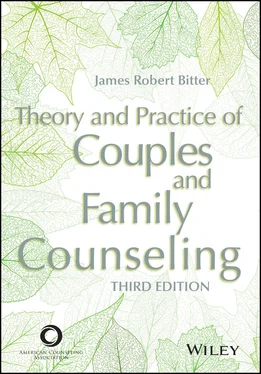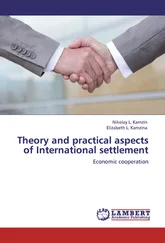James Robert Bitter - Theory and Practice of Couples and Family Counseling
Здесь есть возможность читать онлайн «James Robert Bitter - Theory and Practice of Couples and Family Counseling» — ознакомительный отрывок электронной книги совершенно бесплатно, а после прочтения отрывка купить полную версию. В некоторых случаях можно слушать аудио, скачать через торрент в формате fb2 и присутствует краткое содержание. Жанр: unrecognised, на английском языке. Описание произведения, (предисловие) а так же отзывы посетителей доступны на портале библиотеки ЛибКат.
- Название:Theory and Practice of Couples and Family Counseling
- Автор:
- Жанр:
- Год:неизвестен
- ISBN:нет данных
- Рейтинг книги:5 / 5. Голосов: 1
-
Избранное:Добавить в избранное
- Отзывы:
-
Ваша оценка:
- 100
- 1
- 2
- 3
- 4
- 5
Theory and Practice of Couples and Family Counseling: краткое содержание, описание и аннотация
Предлагаем к чтению аннотацию, описание, краткое содержание или предисловие (зависит от того, что написал сам автор книги «Theory and Practice of Couples and Family Counseling»). Если вы не нашли необходимую информацию о книге — напишите в комментариях, мы постараемся отыскать её.
Theory and Practice of Couples and Family Counseling — читать онлайн ознакомительный отрывок
Ниже представлен текст книги, разбитый по страницам. Система сохранения места последней прочитанной страницы, позволяет с удобством читать онлайн бесплатно книгу «Theory and Practice of Couples and Family Counseling», без необходимости каждый раз заново искать на чём Вы остановились. Поставьте закладку, и сможете в любой момент перейти на страницу, на которой закончили чтение.
Интервал:
Закладка:
In early 1971, one of my professors went to a conference in which a man named Ray Lowe demonstrated Adlerian family counseling. My professor brought back tapes and books, and later he even brought Ray Lowe himself to our campus. I absorbed everything I could about the Adlerian model. The more I read about Adlerian psychology, the more at home I felt. Alfred Adler was systemic before we even had such a word in our profession. He saw people as socially embedded; he took into account the effects of birth order, the family constellation, and family atmosphere; and he considered interaction and doing central to understanding human motivation and behavior. Discovering the works of Adler and Rudolf Dreikurs helped me to make sense out of my own life as well as the lives of the clients entrusted to my care.
I was part of a team that opened up the first public (open-forum) family education center at Idaho State University. I even conducted the first family counseling interview ever done there. I had lots of support and was given lots of room to make mistakes—and to learn. But I had found my approach. As graduate students, we ran parent study groups, held weekly family counseling sessions, and carried what we were learning into local area schools and community agencies. I stayed at Idaho State University to get my doctorate in counselor education. In 1974, we held a conference on Adlerian psychology that featured, once again, Ray Lowe and such masters as Heinz Ansbacher, Don Dinkmeyer, and the man who was to become my best friend and colleague for the second half of my life, Manford Sonstegard.
Sonstegard was simply the best family and group counselor I had ever seen in action. He had an enormously calm manner that reflected what Murray Bowen called a differentiated self . He listened very carefully to the positions and counterposi tions taken in families and groups, and he always stayed focused on redirecting motivation. When I graduated later that year (1974), I was able to get a position in the counseling program of which Sonstegard was the chair. Over the next 13 years, we established and conducted Adlerian family counseling sessions in multiple states in the mid-Atlantic region of the United States from our base in West Virginia.
Adler (1927/1957) had called his approach individual psychology , but it was anything but oriented toward the individual. He used the term “individual” to emphasize the necessity of understanding the whole person (rather than just parts of people) within that person’s social contexts. Adler focused on the individual’s movement through life (one’s style of living) and how that style was enacted with others. He spoke of having a “psychology of use” rather than possession. From Adler’s perspective, people had a purpose and use for the symptoms he encountered in counseling. Others in the clients’ life generally reacted in ways that maintained the very problems for which the individuals sought help. Without question, Adler was a systemic thinker, and working with systems was part of his therapy back in the 1920s. A fuller presentation of Adler’s model is presented in Chapter 6, but I mention his work here because it fit so well with how I saw individuals, groups, couples, and families. I did not have the language of systemic thought when I first read Adler, but the ideas were all there, and his psychology has served as a wonderful foundation for me for more than 45 years.
In 1979, I had the opportunity to attend a monthlong training seminar called a Process Community led by Virginia Satir and two of her trainers. The training program focused on applications of her human validation process model to individuals, groups, couples, and families. Centered in her now-famous focus on communication and self-esteem, it was as much a personal growth experience as it was a learning experience for family practitioners. More than 100 participants were accepted for the program held just north of Montreal, Quebec, in Canada. Half of the participants spoke only English, and half of the participants had a primary language of French, so every word was offered in both languages. The power of Satir’s work in this cross-cultural experience was overwhelming. I came away from the month with a new dedication to experiential teaching and learning and a determination to integrate Satir’s human validation process model with the Adlerian principles I used in clinical practice (see Bitter, 1987, 1988, 1993a; Satir et al., 1988).
In 1980, I became a member of Satir’s AVANTA Network, an association of Satir-trained practitioners who used her methods and processes and were engaged in training others to do the same. For the next 9 years, until her death, I was privileged to work with Satir during three more Process Communities; to coauthor an article and a chapter with her; and to spend at least a week each year learning the newest ideas, hopes, and dreams of one of the most creative family systems therapists ever to have graced our planet.
Virginia Satir taught me the power of congruence in communication as well as the forms that metacommunications often take in relationships. She introduced sculpting to my work and gave me processes for creating transformative experiences with families. Her emphasis on touch, nurturance, presence, and vulnerability put my heart as a person and a counselor on the line, but it also opened up avenues of trust and caring that had been missing in my work before. Satir taught me how to join with families and still not get lost in them. When she died, it was as if I had lost a mother, a father, a sister, and a brother all rolled into one. I had certainly lost one of the best teachers in my life.
In the 1990s, I had two opportunities to do monthlong training programs with Erving and Miriam Polster, the master Gestalt therapists. Their emphasis on awareness, contact, and experiment in counseling fit wonderfully with the decade’s worth of knowledge I had received from Satir. The Polsters also had the same kind of great heart that Satir had. Whether working with individuals, couples, or families, both Satir and the Polsters demonstrated the importance of an authentic and nurturing relationship in facilitating change. At the heart of both models was a dedication to experiential counseling and learning through experiment and enactment. Even today, when I walk into a room to meet a family, I feel the wisdom of these great therapists with me (see Bitter, 2004).
As you can see, I have been gifted with great teachers in my lifetime. They have welcomed me into learning situations that I would not trade for anything in the world. Watching great masters at work has provided me with ideas and models for effective interventions that I never would have discovered on my own. To tell the truth, I often found myself imitating them initially in very concrete ways, sometimes using the exact words and interventions that I had seen them create spontaneously. Over time, I would begin to feel a more authentic integration of their influences in my life and work, and I let these influences inform my own creativity in family practice.
I have become fascinated by the flow and rhythms of therapeutic relationships. The two most important aspects of family practice are still the client and the practitioner, with the latter being in the best position to influence the process. I currently think in terms of four aspects of therapeutic movement: purpose, awareness, contact, and experience (Bitter, 2004; Bitter & Nicoll, 2004). You may already have noticed that the acronym for these words is PACE. In both my personal and professional lives, paying attention to purpose, awareness, contact, and experience brings a useful pace to human engagement and provides me with enough structure to support creativity in my interventions.
Purposefulness has always been a central aspect of Adlerian counseling and provides a sense of directionality and meaning to life (Sweeney, 2019). Awareness and contact are most clearly defined in the Polsters’ Gestalt practice. I consider both of these aspects to be critical to an enlivened and energized life. They make being present sufficient as a catalyst for movement and change. Awareness and contact are also essential to more fully realized human experiences. They allow both the client and the practitioner to touch the authentic within them and to find expressions that flow from their hearts. Such experiences are a natural part of Virginia Satir’s work. The therapeutic experiments and enactments common to systemic family counseling are just one form of such experiences.
Читать дальшеИнтервал:
Закладка:
Похожие книги на «Theory and Practice of Couples and Family Counseling»
Представляем Вашему вниманию похожие книги на «Theory and Practice of Couples and Family Counseling» списком для выбора. Мы отобрали схожую по названию и смыслу литературу в надежде предоставить читателям больше вариантов отыскать новые, интересные, ещё непрочитанные произведения.
Обсуждение, отзывы о книге «Theory and Practice of Couples and Family Counseling» и просто собственные мнения читателей. Оставьте ваши комментарии, напишите, что Вы думаете о произведении, его смысле или главных героях. Укажите что конкретно понравилось, а что нет, и почему Вы так считаете.












